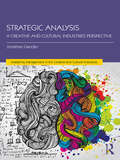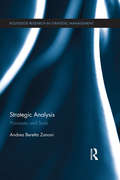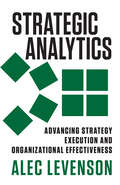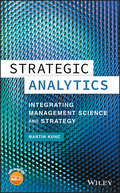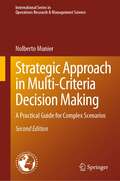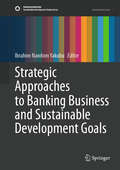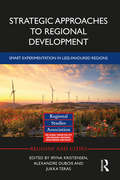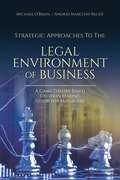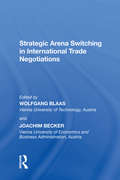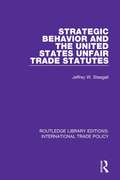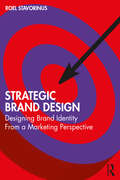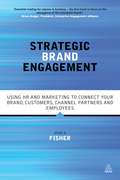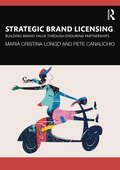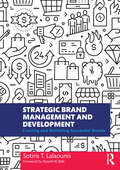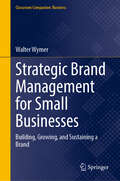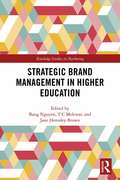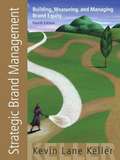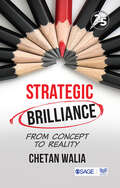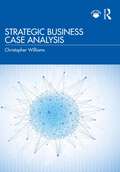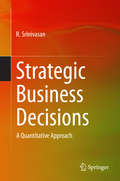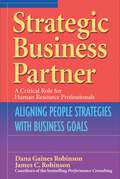- Table View
- List View
Strategic Analysis: A Creative and Cultural Industries Perspective
by Jonathan GanderThough their primary concern, organizations in the creative industries don’t only succeed or fail based on the exercise of their creative resources. Their fortunes also depend on their understanding and approach to the problem of competition.?? In Strategic Analysis: A creative and cultural industries perspective, Jonathan Gander offers a much needed introduction to how the practice of strategic thinking and analysis can be applied to this diverse and dynamic field. The book employs a range of competitive scenarios and case studies in which to practically apply a recommended set of analytical frameworks and examine the strategic challenge facing the enterprise and the wider sector. This concise and practical text focuses on providing a clear series of steps through which to identify and tackle strategic issues facing an enterprise, making it perfect reading for students and practitioners in the creative sector who seek a strategic understanding of the competition they are involved in.
Strategic Analysis: Processes and Tools (Routledge Research in Strategic Management)
by Andrea Beretta ZanoniIn the last few years, competition has become increasingly more complex, variable and dynamic, as can be seen in phenomena like globalization and technological acceleration. To cope with the dynamism and uncertainty of competition, enterprises need capabilities that enable them to respond to competition, as well as to improve their analytical skills and knowledge in order to better manage new strategic projects. Strategic analysis uses both quantitative and qualitative tools to understand both competitive contexts and available company resources. In Strategic Analysis: Processes and Tools, author Andrea Beretta Zanoni develops a theory of strategic analysis and offers models for the application of strategic analysis tools during all phases of the process including planning and decision-making, the development of control, and the formulation of a strategic diagnosis.
Strategic Analytics: Advancing Strategy Execution and Organizational Effectiveness
by Alec LevensonMore than ever, data drives decisions in organizations—and we have more data, and more ways to analyze it, than ever. Yet strategic initiatives continue to fail as often as they did when computers ran on punch cards. Economist and research scientist Alec Levenson says we need a new approach. The problem, Levenson says, is that the business people who devise the strategies and the human resources people who get employees to implement them use completely different analytics. Business analytics can determine if operational priorities aren't being achieved but can't explain why. HR analytics reveal potentially helpful policy and process improvements but can't identify which would have the greatest strategic impact. This book shows how to use an integrated approach to bring these two pieces together. Levenson presents a thorough and realistic treatment of the reasons for and challenges of taking an integrated approach. He provides details on the different parts of both enterprise and human capital analytics that have to be conducted for integration to be successful and includes specific questions to ask, along with examples of applying integrated analytics to address particular organizational challenges.Effective analytics is a team sport. Levenson's approach allows you to get the deepest insights by bringing people together from both the business and HR perspectives to assess what's going on and determine the right solution.
Strategic Analytics: Integrating Management Science and Strategy
by Martin KuncDefines common ground at the interface of strategy and management science and unites the topics with an original approach vital for strategy students, researchers and managers Strategic Analytics: Integrating Management Science and Strategy combines strategy content with strategy process through the lenses of management science, masterfully defining the common ground that unites both fields. Each chapter starts with the perspective of a certain strategy problem, such as competition, but continues with an explanation of the strategy process using management science tools such as simulation. Facilitating the process of strategic decision making through the lens of management science, the author integrates topics that are usually in conflict for MBAs: strategy and quantitative methods. Strategic Analytics features multiple international real-life case studies and examples, business issues for further research and theory review questions and exercises at the end of each chapter. Strategic Analytics starts by introducing readers to strategic management. It then goes on to cover: managerial capabilities for a complex world; politics, economy, society, technology, and environment; external environments known as exogenous factors (PESTE) and endogenous factors (industry); industry dynamics; industry evolution; competitive advantage; dynamic resource management; organisational design; performance measurement system; the life cycle of organisations from start-ups; maturity for maintaining profitability and growth; and finally, regeneration. Developed from the author's own Strategy Analytics course at Warwick Business School, personal experience as consultant, and in consultation with other leading scholars Uses management science to facilitate the process of strategic decision making Chapters structured with chapter objectives, summaries, short case studies, tables, student exercises, references and management science models Accompanied by a supporting website Aimed at both academics and practitioners, Strategic Analytics is an ideal text for postgraduates and advanced undergraduate students of business and management.
Strategic Analytics: Integrating Management Science and Strategy
by Martin KuncDefines common ground at the interface of strategy and management science and unites the topics with an original approach vital for strategy students, researchers and managers Strategic Analytics: Integrating Management Science and Strategy combines strategy content with strategy process through the lenses of management science, masterfully defining the common ground that unites both fields. Each chapter starts with the perspective of a certain strategy problem, such as competition, but continues with an explanation of the strategy process using management science tools such as simulation. Facilitating the process of strategic decision making through the lens of management science, the author integrates topics that are usually in conflict for MBAs: strategy and quantitative methods. Strategic Analytics features multiple international real-life case studies and examples, business issues for further research and theory review questions and exercises at the end of each chapter. Strategic Analytics starts by introducing readers to strategic management. It then goes on to cover: managerial capabilities for a complex world; politics, economy, society, technology, and environment; external environments known as exogenous factors (PESTE) and endogenous factors (industry); industry dynamics; industry evolution; competitive advantage; dynamic resource management; organisational design; performance measurement system; the life cycle of organisations from start-ups; maturity for maintaining profitability and growth; and finally, regeneration. Developed from the author's own Strategy Analytics course at Warwick Business School, personal experience as consultant, and in consultation with other leading scholars Uses management science to facilitate the process of strategic decision making Chapters structured with chapter objectives, summaries, short case studies, tables, student exercises, references and management science models Accompanied by a supporting website Aimed at both academics and practitioners, Strategic Analytics is an ideal text for postgraduates and advanced undergraduate students of business and management.
Strategic Appraisal
by Zalmay Khalilzad Jeremy ShapiroChange--in international relations, in technology, and in society as a whole--has become the idiom of our age. One example of these changes has been an increasing recognition of the value of air and space assets for handling nearly every contingency from disaster relief to war and, onsequently, increasing demand for such assets. These developments have created both challenges and opportunities for the U.S. Air Force. This, the fourth volume in the Strategic Appraisal series, draws on the expertise of researchers from across RAND to explore both the challenges and opportunities that the U.S. Air Force faces as it strives to support the nation's interests in a challenging technological and security environment.Contributors examine the changing roles of air and space forces in U.S.national security strategy, the implications of new systems and technologiesfor military operations, and the role of nuclear weapons in U.S. securitystrategy. Contributors also discuss the status of major modernizationefforts within the Air Force, and the bill of health of the Air Force, asmeasured by its readiness to undertake its missions both today and in thefuture.
Strategic Approach in Multi-Criteria Decision Making: A Practical Guide for Complex Scenarios (International Series in Operations Research & Management Science #275)
by Nolberto Munier Eloy Hontoria Fernando Jiménez-SáezThis book examines multiple criteria decision making (MCDM) and presents the Sequential Interactive Modelling for Urban Systems (SIMUS) as a method to be used for strategic decision making. It emphasizes the necessity to take into account aspects related to real world scenarios and incorporating possible real life aspects for modelling. The book also highlights the use of sensitivity analysis and presents a method for using criteria marginal values instead of weights, which permits the drawing of curves that depicts the variations of the objective function due to variations of these marginal values. In this way it also gives quantitative values of the objective function allowing stakeholders to perform a comprehensive risk analysis for a solution when it is affected by exogenous variables. Strategic Approach in Multi-Criteria Decision Making: A Practical Guide for Complex Scenarios is divided into three parts. Part 1 is devoted to exploring the history and development of the discipline and the way it is currently used. It highlights drawbacks and problems that scholars have identified in different MCDM methods and techniques. Part 2 addresses best practices to assure quality MCDM process. Part 3 introduces the concept of Linear Programming and the proposed SIMUS method as techniques to deal with MCDM. It also includes case studies in order to help document and illustrate difficult concepts, especially related to demands from a scenario and also in their modelling. The decision making process can be a complex task, especially with multi-criteria problems. With large amounts of information, it can be an extremely difficult to make a rational decision, due to the number of intervening variables, their interrelationships, potential solutions that might exist, diverse objectives envisioned for a project, etc. The SIMUS method has been designed to offer a strategy to help organize, classify, and evaluate this information effectively.
Strategic Approach in Multi-Criteria Decision Making: A Practical Guide for Complex Scenarios (International Series in Operations Research & Management Science #351)
by Nolberto MunierThis book examines multiple criteria decision making (MCDM) and presents the Sequential Iterative Modelling for Urban Systems (SIMUS) as a method to be used for strategic decision making. It emphasizes the necessity to take into account aspects related to real world scenarios and incorporating possible real-life aspects for modelling. The book also highlights the use of sensitivity analysis and presents a method for using criteria marginal values instead of weights, which permits the drawing of curves that depicts the variations of the objective function due to increments/decrements of criteria values. In this way, it also gives quantitative values of the objective function allowing stakeholders to perform a comprehensive risk analysis for a solution when it is affected by exogenous variables. Strategic Multi-Criteria Decision Making: A Practical Guide for Complex Scenarios is divided into four parts. Part 1 is devoted to exploring the history and development of the discipline and the way it is currently used. It highlights drawbacks and problems that scholars have identified in different MCDM methods and techniques. Part 2 refers to what can be done using the MCDM process. Part 3 proposes the SIMUS method as a strategic procedure to deal with MCDM problems, and addressing how to approach complicate scenarios. Part 4 is entirely devoted to support practitioners through more than 100 questions a user may ask, and their corresponding answers, as well as a collection of solved six complex real-life scenarios. The decision-making process can be a complex task, especially with multi-criteria problems. With large amounts of information, it can be an extremely difficult to make a rational decision, due to the number of intervening variables, their interrelationships, potential solutions that might exist, diverse objectives envisioned for a project, etc. The SIMUS method has been designed to offer a strategy to help organize, classify, and evaluate this information effectively.
Strategic Approaches to Banking Business and Sustainable Development Goals (Sustainable Development Goals Series)
by Ibrahim Nandom YakubuThis book offers a comprehensive exploration of strategic approaches to banking within the context of sustainable development goals (SDGs). In a world grappling with urgent social, environmental, and economic challenges, banks have a unique role in contributing to sustainable development. This book bridges the gap between theory and practice, offering a strategic framework that enables banks to integrate the SDGs into their decision-making processes. Divided into five parts, it covers essential topics such as green finance, financial inclusion, ethical banking, remittances, and macroeconomic stability, providing a comprehensive understanding of the role of banks in sustainable development. Through case studies, empirical research, and theoretical insights, the book offers practical guidance for aligning banking business strategies with SDGs. Whether you are a banking professional seeking to align your institution's practices with sustainable development, a policymaker crafting regulations for responsible banking, a researcher exploring the potential of sustainable finance, or a student aspiring to understand the role of banks in driving positive change, this book provides essential insights and guidance for leveraging the power of banking to create a more sustainable future. It will also appeal to multinational organizations like the IMF and World Bank, as well as monetary authorities, including central banks. It combines rigorous analysis with practical recommendations, making it an essential resource for anyone interested in the intersection of banking and sustainable development.
Strategic Approaches to Energy Management: Current Trends in Energy Economics and Green Investment (Contributions to Management Science)
by Hasan Dinçer Serhat YükselThis book introduces current managerial approaches to energy production and energy use. The volume analyses how to manage technological developments that contribute to lowering the price of energy production and also focuses on the impact renewable energy sources that provide continuity in energy production and how to manage it. The book presents studies on the effectiveness of wind, solar, biomass, geothermal and hydroelectric energies and discusses current technological approaches to prevent environmental pollution such as carbon capture and storage. Furthermore, the book includes sustainable economic and financial strategies to use energy more effectively and efficiently. It thus appeals not only to an academic readership but also to energy management professionals working in this field.
Strategic Approaches to Regional Development: Smart Experimentation in Less-Favoured Regions (Regions and Cities)
by Iryna Kristensen Alexandre Dubois Jukka TeräsThe existence and persistence of regional disparities between European regions require context-tailored policies to promote structural change. This book explores the congruence between place-based development and regional competitiveness in the EU context. Drawing on a range of social science disciplines, this book unpicks the complexity of regional transformation processes, aiming to enhance the applicability and transferability of theoretical approaches to innovation and place-based regional development in diverse European territorial settings. The contributors have a particular focus on less-favoured regions and on the application of Smart Specialisation – a strategic approach to innovation-based regional development – to the issues at hand. The book comes at a critical moment, meeting the growing demand of academics, practitioners and policymakers with an interest in promoting regional economic growth and well-being.
Strategic Approaches to the Legal Environment of Business: A Game Theory Based Decision Making Guide for Managers
by Michael O'Brien András Margitay-BechtCurrent and future managers are regularly confronted with decisions that create risk in the legal environment of business. This book provides a framework for qualifying legal risk and then determining if the legal risk is worth taking. This framework begins by looking at the relationship between the firm, its suppliers, customers, owners, agents, and others in society as a whole to understand specific risks in personal injury, agreements, products, borrowing money, employees, independent contractors, and business entity selection. When the manager is aware of the magnitude of the risk and the likelihood of the risk, the manager is in a strong position to determine if the risk is worth taking. This book uses numerous applications from Game Theory to determine how risks of the firm compare to risks of another firm, an employee, a vendor and a customer.°Students of business law will appreciate the black letter legal discussions of civil procedure, torts, contracts, the sale of goods, secured transactions, agency, and business associations with tax implications. Aspiring accounting students will find familiarity with many topics that appear on the AICPA exam. Managers will gravitate toward specific guidance with regard to setting up agreements with customers and vendors, creating effective human relations policies, and mitigating firm risks with regard to internal and external stakeholders. Dozens of managers provided input and experience that found its way into the selection of examples in the book ensuring real-world application for many practical business law problems.
Strategic Arena Switching in International Trade Negotiations
by Joachim Becker Wolfgang BlassSince the 1970s global rule-making with respect to international trade has increased in importance. Political and academic attention has been focused either on global institutions like the IMF, the World Bank, the WTO and UN organisations, or on regional blocs like the EU or NAFTA. As negotiations take place in different international arenas, these arenas themselves take on added strategic significance, with agendas pursued and switched from one arena to another, should one route be blocked. While dominant actors have sought to use arena switching to their advantage, subordinate actors have begun to reactivate alternative arenas of negotiation in order to pursue their different agendas. This book employs a multi-level and multi-arena perspective to analyze global rule-making in international trade. It explains why actors - both state and non-state actors - prefer particular arenas. It also addresses the question of which institutional designs serve the aims of specific groups best and how the rules of the different arenas are related.
Strategic Behavior and the United States Unfair Trade Statutes (Routledge Library Editions: International Trade Policy #24)
by Jeffrey W. SteagallThis book, first published in 1995, analyses both theoretically and empirically the effects of a material injury clause of the type found in the Trade Act of 1979 on the behaviour of the dumping or subsidised foreign and import-competing domestic industries. The insight underlying the investigation is that the existence of such a material injury clause in an unfair trade law presents a moral hazard for representatives of the industry because it implies that tariff protection is more likely when the ITC perceives the injury to the US industry to be greater. Therefore, an incentive exists for the US industry to let itself be (or appear to be) injured today in order to benefit from tariff protection in the future.
Strategic Brand Design: Designing Brand Identity From a Marketing Perspective
by Roel StavorinusTranslated from its original Dutch, Strategic Brand Design offers students and professionals a clear overview of the most important steps in developing brand identity from a marketing perspective. It aims to bridge the gap between marketer and designer by containing all the knowledge that both parties need to understand and work together successfully on branding projects.Consisting of four parts, the book begins with a clear explanation of the most important marketing concepts in part 1, followed by a clear step-by-step plan for research and strategy in part 2. Part 3 provides a comprehensive toolkit for brand design based upon that strategy, while part 4 contains a plethora of methods, tools and models for practice as well as questions and assignments to support classroom teaching.Practical, accessible and firmly grounded in research and theory, this book is an ideal reference guide for higher vocational students and students on modules and programs relating to the fields of brand, design, marketing and communication.
Strategic Brand Engagement
by John G FisherThe consumer brand of any organization is crucial to its long term business success. Just as important is the employer brand of the organization, vital to attracting talent and retaining an engaged workforce. Despite the critical connection between internal and external brand engagement, these areas remain firmly entrenched in the traditional silos of HR, internal communication and marketing, wasting resources and even contradicting each other instead of pursuing a common goal. By breaking down traditional silos Strategic Brand Communication offers a new approach for developing brand and employee engagement in any organization. It presents a strategic framework showing how to develop organisational values in line with corporate branding, aligning key HR responsibilities such as recruitment and performance with the overall brand, developing a consistent communications strategy, and measuring the impact of these strategies.
Strategic Brand Licensing: Building Brand Value through Enduring Partnerships
by Pete Canalichio Maria Cristina LongoThis book presents a roadmap for a brand licensing strategy to enable companies to leverage brand value and expand into other product categories or into different markets. Readers will understand both the risks and the benefits of partnerships, how to make the most of a brand's potential in the digital platform, and how to extend a product portfolio through established brands. Brand licensing can be of interest to many stakeholders, including large companies, entrepreneurs, retailers, agencies and even celebrities. This is also a relevant strategy for small and medium-sized enterprises that want to expand their business abroad, reconciling their limited size with their flexibility. Examples of long-standing partnerships are presented and analyzed, with detailed consideration of what has made them so successful.Through the presentation of case studies in the sectors particularly interested in brand licensing, including the art, character, entertainment, fashion, jewelry, sports and toys sectors, this book aims to highlight opportunities, limits and challenges from both the licensor and licensee’s perspectives. In particular, these case studies represent an effective basis for comparing different experiences and brand licensing strategies, allowing readers to understand both best practices and pitfalls to avoid when building an effective and enduring licensing program. Chapter objectives, summaries, key learning points and discussion questions reinforce understanding and aid reflection.Practical yet theoretically grounded, this book is particularly suitable for postgraduate, MBA and executive education students interested in strategic brand management, licensing strategy and brand expansion. This book can also serve as a valuable guide for professionals interested in expanding their brand portfolio.This book provides effective tools to evaluate the strategic side of brand licensing and the selection of the appropriate company to be a licensee. Online resources include PowerPoint slides, a test bank of exam questions, a case list and discussion questions.
Strategic Brand Management and Development: Creating and Marketing Successful Brands
by Sotiris T. LalaounisBringing together theories and concepts from brand management, consumer culture theory, marketing, communications, and design, this book provides an understanding of how organisations can successfully develop, market, and manage their brands. It draws extensively from scholarly research published in social sciences and humanities to provide a detailed discussion of the process of brand management and development. This book explores how organisations can design brand identities, develop brand marketing programmes, measure brand performance, and sustain brand equity, combining psychological, sociological, cultural, and management perspectives. It provides numerous examples that contextualise theory, enabling the reader to understand how past and present branding campaigns and strategies can be deconstructed, analysed, and evaluated, using these theoretical insights.With end-of-chapter case studies on Burberry, Juventus F.C., Pukka Herbs, Yo!, and many other European and global brands, Strategic Brand Management and Development is an essential text for students in marketing, brand management, and consumer research, or for anyone interested in understanding the extraordinary power and scope of brands and branding in contemporary post-modern society.
Strategic Brand Management for Small Businesses: Building, Growing, and Sustaining a Brand (Classroom Companion: Business)
by Walter WymerWith small businesses, the business is the brand, in contrast to corporations that have a portfolio of branded products. Therefore, effective brand management is dependent upon the business growing its brand into a strong brand. This comprehensive textbook helps students to navigate the dynamic world of branding for small and medium sized enterprises. It provides a strong conceptual and analytical foundation to brand management that can be applied to small business. It also addresses the unique challenges and opportunities that small businesses face in establishing, nurturing, and leveraging their brands for long-term success. Each chapter features learning objectives, vignettes, key terms, chapter discussion questions, and mini cases. To assist in teaching from this text, PowerPoint sides, test banks, sample syllabi, and sample student projects are available to professors and lecturers online. Written in a direct, accessible style for easy learning and understanding complex concepts and ideas, this book is ideal for advanced undergraduate and graduate course work as well as small to medium-sized business professionals.
Strategic Brand Management in Higher Education (Routledge Studies in Marketing)
by Bang Nguyen Jane Hemsley-Brown T. C MelewarUniversity branding has increased substantially, due to demands on universities to enrol greater numbers of students, rising tuition fees, the proliferation of courses, the growing 'internationalization' of universities, financial pressures, and reliance on income from foreign students. As higher education continues to grow, increased competition places more pressure on institutions to market their programs. Technological, social, and economic changes have necessitated a customer-oriented marketing system and a focus on developing the university brand.This book is unique in providing a composite overview of strategy, planning, and measurement informed by ground-breaking research and the experiences of academics. It combines theoretical and methodological aspects of branding with the views of leading exponents of branding in different contexts and across a range of higher education institutions. Expert contributors from research and practice provide relevant and varying perspectives allowing readers to access information on international trends, theory, and practices about branding in higher education.Readers are exposed to the critical elements of strategic brand management, gain insights into the planning process of higher education branding, and gain a solid understanding of the emerging research area of branding concepts in higher education. Advanced students, and researchers will find this book a unique resource and it will also be of interest to brand practitioners in both education and public sector markets.
Strategic Brand Management: Building, Measuring, and Managing Brand Equity
by Kevin KellerKevin Lane Keller is recognized as one of the international leaders in the study of strategic brand management and integrated marketing communications. In Strategic Brand Management: Building, Measuring, and Managing Brand Equity , 4th Edition Keller looks at branding from the perspective of the consumer, and provides a framework that helps students and managers identify, define, and measure brand equity. Using insight from both academics and industry practitioners, the text draws on illustrative examples and case studies of brands marketed in the US and all over the world.
Strategic Brilliance: From Concept to Reality
by Chetan WaliaWas it ‘big thinking’ behind the brilliant minds of Walt Disney, Steve Jobs, Warren Buffet, Mahatma Gandhi, Nelson Mandela, and Mother Teresa that made them achieve remarkable breakthroughs that have changed the world in many ways? Every business education and training programmes encourage us to ‘think big’ and be ‘excellent’. But they do not teach us to be brilliant. While excellence is the quality of being extremely good at something, brilliance is an exceptional level of performance. Strategic Brilliance: From Concept to Reality is a brilliant work of ideas that enlightens readers on the art of ‘brilliance’ and exposes the wildly ambitious and dramatized idea of ‘think big and the rest will follow’ mindset. It outlines a journey from perceiving brilliance to a roadmap for executing it. Guiding the reader through a process of clarifying assumptions, confronting problems and articulating decisions, the book equips business leaders, budding entrepreneurs and strategy enthusiasts to challenge the existing paradigms about success, develop a mindset for brilliance and create a strategic blueprint to achieve it.
Strategic Business Case Analysis
by Christopher WilliamsThis textbook provides students with the skills and techniques necessary to analyse business case studies from a strategic perspective. With career development and impact in mind, the book goes beyond simply listing tools, instead teaching students how to prepare for a major strategic business case analysis project, how to position their analysis on a spectrum from reductionist to holistic approaches, how to critically engage with theory and case data, as well as how to leverage their work after completion. A logical approach is offered, taking the reader through the analysis journey, from preparing to analyse a case study to conducting the analysis and maximising the impact going forwards. A comprehensive analysis task is incorporated, which asks the reader to reflect on a range of case data, understand the choices of analytical positioning and tool selection, and develop an analysis based on this positioning. Further pedagogical features include: Reflective practice exercises at the end of chapters, allowing the student to self-identify areas of strength and weakness as they develop through the process. Worked examples based on cases reproduced in the book, allowing the student to follow the analytical process that the author went through in different analysis modes. Quotes and analysis insights from former students who have previously conducted a strategic business case analysis, aiding reflective practice. As case study analysis continues as a core component of teaching across business schools, this unique text will help to build key skills in advanced undergraduate, postgraduate, MBA, and executive education students conducting strategic business case analysis. Support material includes PowerPoint slides as well as video content.
Strategic Business Decisions
by R. SrinivasanThis book presents the essential concepts of operations research and engineering management in a structured manner. Starting with the basic functions of management - planning, organizing, leading and controlling - it introduces the reader to the process of strategic decision-making, covering the essentials of technological invention management, innovation and entrepreneurship, with ample examples of decision-making under certainty, uncertainty and risk conditions. It also exposes the reader to the fundamentals of managing projects and professional communication. In order to reinforce the theory used, practical case studies taken from relevant disciplines are introduced. For instance, case studies from the retail sector have been appended to the assignment problem and cases related to traffic have been introduced for queuing formulation. The concept of game theory is discussed in greater detail with an introduction to topics such as incentive compatibility, Bayesian representations for different games, budget balance, auctions and a broad coverage of mechanism design. While a few of these problems have been solved in the book, a few others have been left un-solved to promote readers' understanding. The mix of theoretical and practical examples reveals to the reader the underlying complexities and highlights the challenges entailed by field implementation.
Strategic Business Partner: A Critical Role for Human Resource Professionals
by Dana Gaines Robinson James C. RobinsonOrganizations are becoming increasingly complex, and the requirements to manage and optimize the people working in these organizations are also becoming more complex.
